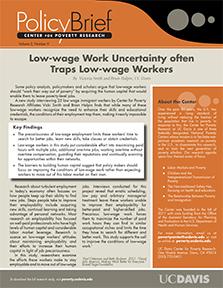Low-wage Work Uncertainty often Traps Low-wage Workers
by Victoria Smith and Brian Halpin, UC Davis
Some policy analysts, policymakers and scholars argue that low-wage workers should “work their way out of poverty” by acquiring the human capital that would enable them to leave poverty-level jobs.
A new study interviewing 25 low wage immigrant workers by Center for Poverty Research Affiliates Vicki Smith and Brian Halpin finds that while many of these low-wage workers recognize the need to enhance their skills and educational credentials, the conditions of their employment trap them, making it nearly impossible to escape.
Key Findings
- The precariousness of low-wage employment limits these workers’ time to search for better jobs, learn new skills, take classes or obtain credentials.
- Low-wage workers in this study put considerable effort into maximizing paid hours with multiple jobs, additional one-time jobs, working overtime without overtime compensation, guarding their reputations and continually scanning for opportunities within their networks.
- The barriers to building human capital suggest that policy makers should focus on improving the conditions of low-wage work rather than expecting workers to move out of this labor market on their own.
Research about turbulent employment in today’s economy often focuses on how people keep up their ability to find new jobs. Steps people take to improve their employability include acquiring new skills, continual learning and taking advantage of personal networks.
Most research on employability has focused on well-paid professionals who have high levels of human capital and considerable labor market leverage. Research is scarce on low-wage workers’ attitudes about maintaining employability and their efforts to increase their human capital in light of job precariousness.
In this study, researchers examine the efforts these workers make to stay employable and to move out of low-wage jobs. Interviews conducted for this project reveal that erratic scheduling, low pay and arbitrary managerial treatment leave these workers unable to improve their employability for better-paid and higher-skilled jobs.
Precarious low-wage work forces them to maximize the number of paid work hours they can find in similar occupational niches and limits the time they have to search for different and better work. This study supports the call to improve the conditions of low-wage work.
Interviewing Low-wage Workers
For this exploratory study, researchers conducted in-depth
interviews with 25 low-wage workers in the Napa/Sonoma area in
the fall of 2012. Interviewees were drawn from several sectors,
including food service (13), landscaping (9), domestic work and
office cleaning (6) and construction (6). Some interviewees
worked in multiple sectors.
Interviewees were first and 1.5 generation immigrants. They were obtained through chain referral (“snow ball”) sampling. Interviewees were asked to enumerate all jobs held in the previous five years, to describe current jobs, how they found jobs, how they gained skills, their short- and long-term job plans, whether and how they utilized friendship and kin networks to gain information and find jobs, barriers they faced to upward mobility as well as steps they had taken to gain new skills, take courses and improve their employability.
Characteristics of low-wage workers in the
U.S. in 2011
- Average age is 34.9 years old.
- Over 38% of these workers are between 35 and 64 years old.
- 33.3% have some college education.
- 55% are women and 45% are men.
- 56.9% are white, 23% are Latino, and 14.3% are black.
The Precariousness of Low-wage Jobs
Low-wage employment is often erratic and precarious, limiting
workers’ ability to learn new skills and search for better jobs.
Typically, low-wage jobs are part-time with no guaranteed hours,
making it difficult for individuals to manage time effectively
across work and non-work areas of their lives. Many employers
expect workers to be on-call and available if needed, even
sometimes for 12-hour shifts without advanced notice.
This uncertainty leaves workers vulnerable to the capriciousness of management and often unable to have any control over their schedules. This makes it extremely difficult for these workers to take advantage of education and training opportunities which require scheduled attendance.
To cope and sustain their economic livelihoods, these workers focus on maintaining the jobs they have while searching for additional opportunities through relatives, friends and occupational networks. They piece together multiple full- and part-time jobs, often endeavoring to distribute jobs across time to maximize their paid hours. For example, they will defer a request from an employer, stagger jobs, and continually scan their networks for news of additional one-time job opportunities.
Horizontal Mobility and a “Regular” Job
Many interviewees described how they attempted to learn new
skills in their current occupational niche when possible, such as
a housecleaner learning how to clean offices, or a worker who
sets up tables and chairs at events for a catering company
learning how to make special desserts. However, these new skills
often offer horizontal but not vertical mobility.
Low-wage workers interviewed for this project said they would prefer stable long-term jobs with stable work hours. In other words, like many workers today they yearn for a “regular” job.
Unlike many workers, they are highly constricted in pursuing this dream. They describe ways they endeavor to maintain good reputations with their employers, which enhances the likelihood they will be given more hours and be recommended for other opportunities.
A Productive, High-quality Workforce
Low-wage workers can be a productive, high-quality workforce
despite lacking the human capital of more highly educated,
professional workers. Research repeatedly finds that these
workers hold strong work ethics, desire stable employment and are
willing to learn but find it difficult to escape the low-wage
labor market.
Worker and labor market advocates should educate employers about the benefits of guaranteeing stable and adequate schedules rather than subjecting them to arbitrary and erratic work hours, or overtime hours without enhanced overtime pay.
Raising the minimum wage or introducing living wages could create more possibilities for workers to support themselves and their families on full-time work while potentially freeing up time to develop their human capital. This could also increase efficiency and productivity for the economy as a whole.
This might be possible with the recent decision to raise the minimum wage in California to $10 an hour by 2016. California’s AB 241, the Domestic Workers Bill of Rights, which requires overtime pay for in-home child care and health care workers, could also advance this goal.
Victoria Smith is a Professor of Sociology at UC Davis and a Center for Poverty Research Faculty Affiliate. She studies changes in the organization of work, in employment relationships, and in job searching strategies.
Brian Halpin is a Ph.D. candidate in Sociology at UC Davis and the 2011 recipient of the Mayhew Award for Outstanding Graduate Student Paper. He studies Labor Markets, Political Economy and Ethnography.
References
and Further Reading
Desilver, Drew. Dec
4, 2013. “5 Facts about the minimum wage.” Pew Research Center.
<http://www.pewresearch.org/fact-tank/2013/12/04/5-facts-about-the-minimum-wage/>.
Osterman, P. and Beth Shulman. 2011. “Good Jobs America: Making Work Better for Everyone.” Russell Sage Foundation.
Schmitt, John and Janelle Jones. 2012. “Low-wage Workers are Older and Better Educated than Ever.” Center for Economic and Policy Research. <http://www.cepr.net/documents/publications/min-wage3-2012-04.pdf>.
U.S. Bureau of Labor Statistics. Nov 27, 2013. “May 2012 National Occupational Employment and Wage Estimates United States.” <http://www.bls.gov/oes/current/oes_nat.htm>.

















